Chief Bug: Yo, Boss. Question here. You think you made us small enough?
Creator: You would rather not exist?
SpokesBug: No, Boss, no, never crossed my mind. It's just that,
we like this place you gave us and all, but we were thinking that with
all this space…
Creator: Space is required for all of your species.
SpokesBug: That's another thing. You made how many…
Creator: Half a million .
SpokesBug: …different insects? Half million. Yea…you
want to tell us why?
Creator: I like diversity.
SpokesBug: Couldn't get it right the first 499,999 times, huh?
Creator: You would rather not exist?
SpokesBug: Hey, just a joke, right? But about this six legs
business, that was on purpose?
Creator: Some have more. Tomorrow I make fish. They
won't have any.
SpokesBug: Water types got you ticked, huh?
Creator: Fish will eat insects.
SpokesBug: Oh, well… about that. You sure you don't
want us to be bigger? I mean, like maybe you were distracted when
you were making up size charts or something?
Creator: Everything I make is perfect.
SpokesBug: Uh, yea. Well, seems like our perfection is on the short side.
Creator: There are compensating factors.
SpokesBug: Yea, sure, whatever you say.
Creator: You will outlive all of your enemies.
SpokesBug: All of them? Cool.
Creator: Not you personally, but collectively you will survive.
SpokesBug: Oh. But we'll still be in charge, right?
Creator: No. In a short while I will make man. He
will rule the world.
SpokesBug: And he's going to be big, I suppose.
Creator: I haven't decided. Most likely.
SpokesBug: Great. And…don't tell me…he'll eat us too.
Creator: No.
SpokesBug: That's better.
Creator: He will use you to catch fish.
SpokesBug: And that's fair?
Creator: You would rather not exist?
The earliest records of fly fishing describe something that was
probably a soft hackle. Long feather barbs of some Mediterranean
bird undulated temptingly in the unspoiled waters of yesteryear, barbs
that represented the appendages of any of several thousand insects in
their aquatic stage. The perfect generic fly. Thousands of years later,
the simplest of soft hackle fly constructs will still catch fish, often when
exact replica patterns fail. Why? Soft-hackles represent the emerging
form of many possible insect-ish somethings. They work as well on warm
water species as they do on cold water stream fish. Given the choice of
all fly patterns to bring on survival training, the best choice would be a
soft hackle. But if you forgot, with a hook and string and a single feather,
tying one could not be simpler.
GENERIC SOFT HACKLE – Thread body
Hook: Mustad 3906B, 9671, Dai-Riki #305 or equivalent.
Hook Size: 8-14.
Thread: Flat waxed nylon.
Head: Thread.
Tail: (optional) A few hackle barbs.
Body: Thread with (optional) wire windings.
Thorax: (optional) Bead or ultra chenille or peacock herl.
Collar: Partridge, guinea hen, starling feather, hen neck.
Weight: (optional) Lead wire (where legal).
METHOD – Thread body
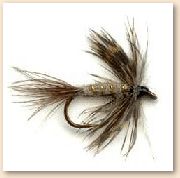
1. (optional) If you are using a bead for the thorax, put it on the
hook and slide it to the hook eye.
2. Wrap hook shank with thread to form a base for other materials.
3. (optional) Tie in wire towards the hook bend with excess
wire hanging off past the bend.
4. If you are not using a bead for the thorax, put 8-10 wraps
of lead wire around the middle of the hook shank and cover
with thread.
5. Bring your tying thread toward the bend and stop before the
bend actually starts.
6. Build up a body of thread in a long conical form
building toward the thorax.
7. If you are using chenille or herl for the thorax, tie in
at that point and make two or three turns to create a
round thorax. If you are using a bead for the thorax,
bring the thread over the bead (one strand is all that is
required and wind once or twice in front of the bead.
8. (optional) wrap the wire over the thread until it reaches
the thorax, clip and cover the clipped end with a couple of
wraps of thread.
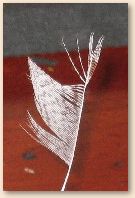 9. Take a soft hackle feather (starling, hen neck, partridge,
guinea hen) and strip one side of the feather of all barbs. [As
you look at the feather with the concave (dull) side away from
you, you want to strip the right side of the feather.] Fold back
the remaining barbs leaving only 5 or six nearest the tip of the
feather and tie in the feather at the gap you have made in front
of the thorax.
9. Take a soft hackle feather (starling, hen neck, partridge,
guinea hen) and strip one side of the feather of all barbs. [As
you look at the feather with the concave (dull) side away from
you, you want to strip the right side of the feather.] Fold back
the remaining barbs leaving only 5 or six nearest the tip of the
feather and tie in the feather at the gap you have made in front
of the thorax.
8. Holding the stem, wrap the hackle clockwise (with the
concave side toward the hook shank) 2-3 times until a sparse
but even umbrella of barbs has formed.
9. Tie off and whip finish a small round head.
10. Coat head with Hard as Nails.
HOW TO FISH A SOFT HACKLE:
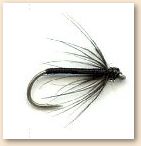 In Moving Water:
In Moving Water:
There are several ways to fish soft-hackles, whether singly or in multiple
fly combinations.
First try the traditional method of casting across the stream. Create
a gentle downstream belly in the line and allow the tension on the line
to swing the fly through the current. Be ready for a strike anywhere
along the path of the swing, but particularly as the line fully straightens
because, as the fly rises to the surface, it will look like and emerging insect.
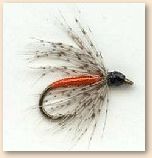 Alternatively, using a strike indicator, cast upstream, dropping the
fly line on the water with slack so that the fly has time to sink. As
the fly drifts downstream, mend so that the fly can sink without little
drag. Takes on a soft hackle are usually not as subtle as on a nymph
and many will completely submerge the strike indicator.
Alternatively, using a strike indicator, cast upstream, dropping the
fly line on the water with slack so that the fly has time to sink. As
the fly drifts downstream, mend so that the fly can sink without little
drag. Takes on a soft hackle are usually not as subtle as on a nymph
and many will completely submerge the strike indicator.
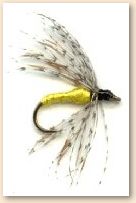 If you have a good idea of a trout's location, you can cast down
and across slightly above the target trout which will cause the fly
to sink just a little then rise shortly afterward, like an emerger.
If you have a good idea of a trout's location, you can cast down
and across slightly above the target trout which will cause the fly
to sink just a little then rise shortly afterward, like an emerger.
In Still Water:
Cast the fly past the target location and let it sink. Using very
small strips retrieve the fly with a strip-long pause-strip-long
pause-strip-wait until you can't stand it method. Bass usually
hit on the strip, and bluegill hit on the pause. Using a popper
dropper rig is probably the most effective method. Any twitch
of the popper you didn't cause means a bluegill is tasting the fly.
The second twitch is a bite. Set the hook hard. ~ Bob
About Bob:
Robert Lamar Boese has fly fished for five decades. He is an
environmental negotiator, attorney and educator who has provided
environmental legal services for more than thirty-three years including
active duty with the U.S. Coast Guard and Department of Justice. He is a
well known fly tyer with several unique patterns to his credit. He has
developed and authored federal and state regulatory programs
encompassing a broad spectrum of environmental disciplines, has
litigated environmental matters at all levels of the federal and state
court systems, and is a qualified expert for testimony in environmental
law. He has authored over 60 published text chapters, comments or
articles on environmental matters, is a member of the Colorado, District
of Columbia and Louisiana Bar Associations, and is a certified mediator.
In addition to his legal practice, Mr. Boese has been a high school
teacher, an associate professor of Environmental Law and Public Health,
has authored numerous fiction and sports publications, and is a softball
coach and nationally certified volleyball referee. He is the president
of the Acadiana Fly Rodders in Lafayette, Louisiana and editor of
Acadiana on the Fly. He has been married for thirty years and is the
father of two fly fishing girls (25 and 21). For additional information
contact: Boese Environmental Law, 103 Riviera Court, Broussard, LA 70518
or call 337.856.7890 or email coachbob@ymail.com.
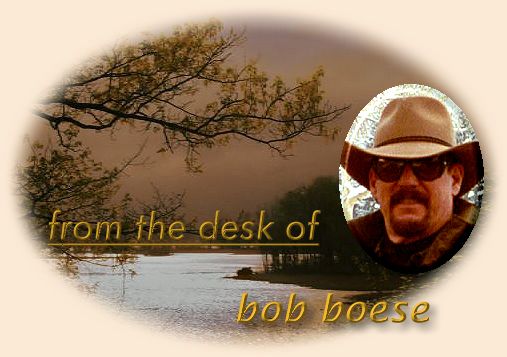

 In Moving Water:
In Moving Water:
 9. Take a soft hackle feather (starling, hen neck, partridge,
guinea hen) and strip one side of the feather of all barbs. [As
you look at the feather with the concave (dull) side away from
you, you want to strip the right side of the feather.] Fold back
the remaining barbs leaving only 5 or six nearest the tip of the
feather and tie in the feather at the gap you have made in front
of the thorax.
9. Take a soft hackle feather (starling, hen neck, partridge,
guinea hen) and strip one side of the feather of all barbs. [As
you look at the feather with the concave (dull) side away from
you, you want to strip the right side of the feather.] Fold back
the remaining barbs leaving only 5 or six nearest the tip of the
feather and tie in the feather at the gap you have made in front
of the thorax. Alternatively, using a strike indicator, cast upstream, dropping the
fly line on the water with slack so that the fly has time to sink. As
the fly drifts downstream, mend so that the fly can sink without little
drag. Takes on a soft hackle are usually not as subtle as on a nymph
and many will completely submerge the strike indicator.
Alternatively, using a strike indicator, cast upstream, dropping the
fly line on the water with slack so that the fly has time to sink. As
the fly drifts downstream, mend so that the fly can sink without little
drag. Takes on a soft hackle are usually not as subtle as on a nymph
and many will completely submerge the strike indicator. If you have a good idea of a trout's location, you can cast down
and across slightly above the target trout which will cause the fly
to sink just a little then rise shortly afterward, like an emerger.
If you have a good idea of a trout's location, you can cast down
and across slightly above the target trout which will cause the fly
to sink just a little then rise shortly afterward, like an emerger.